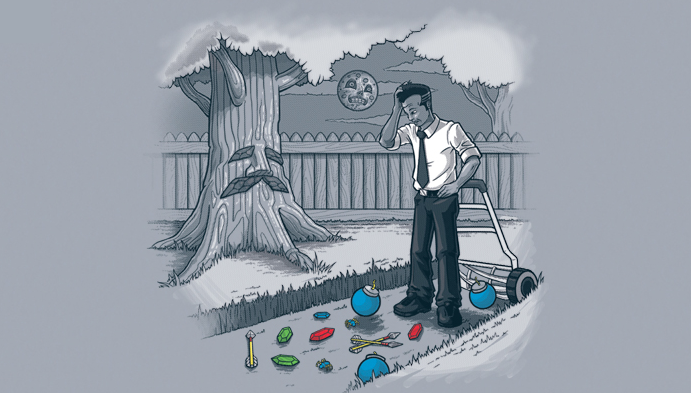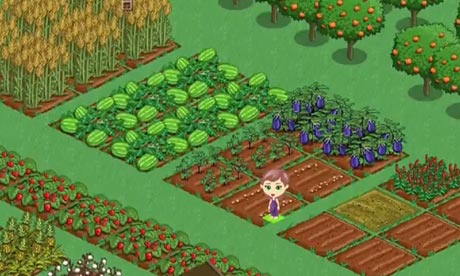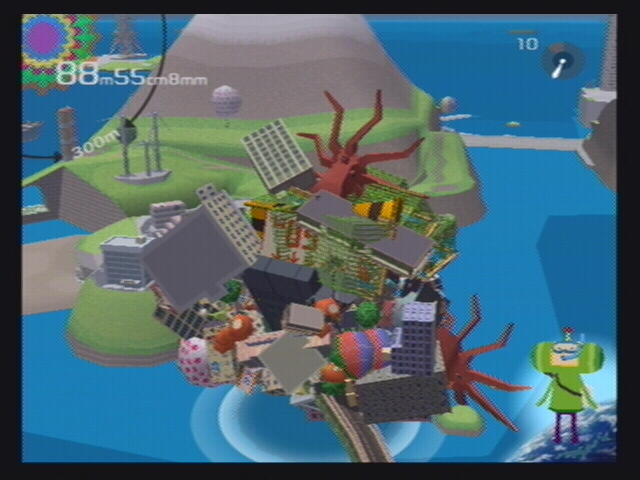Whatever game you're playing, you can almost always find some aspect of that game that is about acquisition of stuff. This "stuff" can be of a few kinds: things with a physical representation in the game world (coins, ammo, helmets, new levels), things that have value within the mechanics of the games but no physical representation (extra hearts, level-ups, skill points), or things that have no inherent gameplay value but some other kind of worth to the player (achievements, special endings, easter eggs).
 |
| I guess when you play the Song of Time all this stuff gets recycled back into grass? |
What this Stuff does for players varies by game and by type of Stuff - we've explored already how
feedback can be used to guide players along certain paths, and Stuff is both a kind of feedback and a mechanism for giving feedback. You learn that cutting grass gets you rupees, so you cut all the grass; you learn that the blue goo makes walls and floors bouncy, so you experiment with finding new ways to direct and redirect the blue goo so you can get to new areas. But why do we want the rupees, or the new area? Usually the answer to this is: so that we can
do more things. We like new powers, new challenges, new places, new things to do. Implicit in each fabulous new weapon you pick up in Diablo 2 (marginally better than the fabulous new weapon you picked up 3 hours earlier) is the feeling: "Awesome, now I'm gonna be able to kill ten more of those little goblin things every minute!" When you beat a level, you get pumped and excited about the next level and all the things you get to do there.
But I don't want the idea of more-things-to-do to undercut the feedback power of getting Stuff, because using Stuff as a feedback mechanism is one of the sharpest tools in addictive game design - for better or for worse. MMORPGs give you tiny incremental gains, Tetris gives you line-clearing, Facebooks game gives you little points and stats and notifications.
 |
| Yay! I got a new, um, eggplant? I never played FarmVille. |
The games that are often the most addictive are the ones with the most rapid rewards structures. In general, if you can give out lots of little rewards, you can keep players' interest piqued. You'll just want to turn the next corner, to meet the next character, to gain one last skill point.
 |
| This is how weekends are lost. |
This isn't as easy as it seems. Coming up with a game that can perpetually give you rewards while still keeping those rewards meaningful is
really, really hard. Add more stuff, and you can run into balance or
complexity problems. Throughout World of Warcraft, balance is maintained so that the little boosts you get gradually draw new challenges into the realm of possibility. And the fact that they can keep players doing this for as long as they can is what makes the game so addictive (and why, I'd argue, the game is borderline amoral; "addictive" isn't a word I'm using with any hyperbole here). For any game you hear described as "addictive," think of the things players
get in that game, and how frequently they get them; this is very likely a big part of
why the game is addictive.
There are plenty of more benign examples of how a fast-paced rewards structure can be used to keep a game exciting. A good one is Katamari Damacy, which gives you the satisfaction of picking up all those little items, of sizing up and suddenly being able to go new places or pick up new things, of going from not being able to pick up a banana to lifting buildings out of the ground in a 10-minute span.
 |
| It's only a matter of time for that mountain, too. |
Katamari certainly feels addictive a lot of the time, and this is a big part of why; you always want to do just a little better, to get that ball of weird stuff just a little bigger. Moreover, the frequent incremental gains keep things moving at a quick pace, and as you build momentum you want to maintain it as best you can. At the same time, there are upper limits on this, and eventually you will wear yourself out on the game or complete it. That's because games like this one are designed to be a finite experience. You can continue to improve and collect, but there's a last level you can beat, and a limited number of secret items to find. But throughout that finite experience, the rapid affirmation of your progress by way of Stuff - new levels, bigger Katamari, less traumatic derision from the main character's father - is key to enjoyment of the game.
A lot of games do very well with a slower-paced rewards structure - Shadow of the Colossus comes to mind - because the games themselves are slower paced. In SotC, the rewards you get aren't always overt; you grow a little more powerful with each monster you kill, and you get the satisfaction of watching a cutscene of the monster's death, but sometimes it's just as enjoyable to be riding through the silent landscape towards your next encounter. Having the game's major rewards be more spread out heightens the anticipation. Slower reward pacing helps players appreciate rewards; faster reward pacing helps increase momentum and excitement; and incredibly high pacing can either burn players out or become addictive, depending on how it's implemented. Try watching, as a player, for the rewards that the game gives you, and think about what reaction they're seeking from you by giving you those rewards.




Katamari strikes me as an especially keen example of this phenomenon. This isn't because it's more addictive (necessarily) than other games, but because you can see the progression in scale so clearly. As you mentioned, watching your power of acquisition scale from banana --> mountain is exhilarating. Looking from level to level, you can feel the difference it makes to start with an eraser-sized, lamp-sized, or person-sized Katamari.
ReplyDeleteConsequently, the game is also a very good illustration of the limits of this cycling process of acquisition and growth. After mountain, there isn't much left. It isn't fun to "get" things when they no longer have any significance to your progression. The final level of Katamari is a pretty hard limit. Same goes for WoW – the game breaks when the top levels or items aren't meaningfully superior to those before them. Thus, Blizzard needs to continue to release new playgrounds for their players to advance in – but with each release, the buzz of advance is a little less relevant and a little less interesting. Once the thrill of acquisition (items, levels) goes away, you are only left with a hollow feeling of clicking and going through the motions.
Browser games, and arcade games before them, have shown that this can be enough to keep players at the console/website/whatever, but it feels pretty crappy to waste hours trying to beat your record on Winterbells. http://www.ferryhalim.com/orisinal/g3/bells.htm